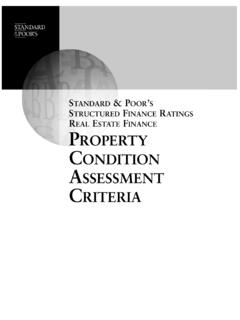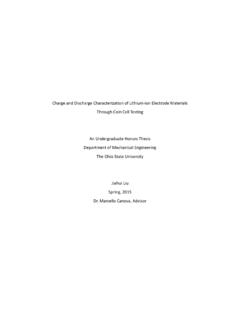Transcription of THERMODYNAMICS: COURSE INTRODUCTION
1 - 1 -UNIFIED ENGINEERING 2000 Lecture Outlines Ian A. WaitzTHERMODYNAMICS: COURSE INTRODUCTIONC ourse Learning Objectives:To be able to use the First Law of thermodynamics to estimate the potential for thermo- mechanical energy conversion in aerospace power and propulsion outcomes ( assessment method) :1) To be able to state the First Law and to define heat, work, thermal efficiency andthe difference between various forms of energy. (quiz, self- assessment , PRS)2) To be able to identify and describe energy exchange processes (in terms ofvarious forms of energy, heat and work) in aerospace systems.
2 (quiz, homework,self- assessment , PRS)3) To be able to explain at a level understandable by a high school senior or non-technical person how various heat engines work ( a refrigerator, an IC engine,a jet engine). (quiz, homework, self- assessment , PRS)4) To be able to apply the steady-flow energy equation or the First Law ofThermodynamics to a system of thermodynamic components (heaters, coolers,pumps, turbines, pistons, etc.) to estimate required balances of heat, work andenergy flow. (homework, quiz, self- assessment , PRS)5) To be able to explain at a level understandable by a high school senior or non-technical person the concepts of path dependence/independence andreversibility/irreversibility of various thermodynamic processes, to represent thesein terms of changes in thermodynamic state, and to cite examples of how thesewould impact the performance of aerospace power and propulsion systems.
3 (homework, quiz, self- assessment , PRS)6) To be able to apply ideal cycle analysis to simple heat engine cycles to estimatethermal efficiency and work as a function of pressures and temperatures at variouspoints in the cycle. (homework, self- assessment , PRS)Teaching & Learning Methods1) Detailed lecture notes are available on the web (for viewing and/or downloading).You should download a copy of these and bring them with you to lecture. 2) Preparation and participation will be important for learning the material. You willbe responsible for studying the notes prior to each lecture.
4 Several reading- 2 -assignments will be given to help promote this activity (1/3 of participationgrade).3) Several active learning techniques will be applied on a regular basis (turn-to-your-partner exercises, muddiest part of the lecture, and ungraded concept quizzes).We will make extensive use of the PRS system (2/3 of participation grade).4) Homework problems will be assigned (approximately one hour of homework perlecture hour). The Unified Engineering collaboration rules 3 -UNIFIED ENGINEERING 2000 Lecture Outlines Ian A. WaitzTHERMODYNAMICS CONCEPTSI.
5 thermodynamics (VW, S & B: Chapter 1)A. Describes processes that involve changes in temperature,transformation of energy, relationships between heat and It is a science, and more importantly an engineering tool, that isnecessary for describing the performance of propulsion systems,power generation systems, refrigerators, fluid flow, combustion,..C. Generalization of extensive empirical evidence (however mostthermodynamic principles and can be derived from kinetictheory)D. Examples of heat enginesCombustion HeatSolar HeatNuclear Heat Heat Engine[] mechanical WorkElectrical Energy Waste Heat[]OR mechanical WorkElectrical Energy Heat[]FuelAir + fuelV2, T2 AirV1, T1 Waste HeatElectricityFuelAir ElectricityHeat1.
6 Propulsion system 2. power generation 3. Refrigerator- 4 -E. Questions:1. Describe the energy exchange processes in _____ (fill in the blank, a nuclear power plant, a refrigerator, a jet engine).2. Given that energy is conserved, where does the fuel+oxidizer energy that isused to power an airplane go?3. Describe the energy exchange processes necessary to use electricity from anuclear power plant to remove heat from the food in a Describe the energy exchange processes necessary for natural gas to be usedto provide electricity for the lights in the room you are Concept of a thermodynamic system (VW, S & B: )A.
7 A quantity of matter of fixed identity, boundaries may be fixed ormovable, can transfer heat and work across boundary but notmassForce x distance (work)System boundaryHeat (Q) Electrical energy(work)System boundaryB. Identifiable volume with steady flow in and out, a control more useful way to view devices such as enginesSystem boundarycomplex processm, p1,T1m, p2,T2- 5 -III. Thermodynamic state of a systemA. The thermodynamic state of a system is defined by specifying a setof measurable properties sufficient so that all remainingproperties are determined. Examples of properties: pressure,temperature, density, internal energy, enthalpy, and For engineering purposes we usually want gross, average,macroscopic properties (not what is happening to individualmolecules and atoms) thus we consider substances as continua --the properties represent averages over small volumes.
8 Forexample, there are 1016 molecules of air in 1 mm3 at standardtemperature and pressure. (VW, S & B: ) . Intensive properties do not depend on mass ( p, T, , v=1/ , uand h); extensive properties depend on the total mass of thesystem ( V, M, U and H). Uppercase letters are usually usedfor extensive properties. (VW, S & B: )D. Equilibrium: States of a system are most conveniently describedwhen the system is in equilibrium, i. e. it is in steady-state. Oftenwe will consider processes that change slowly -- termed quasi-steady. (VW, S & B: )ForcePressureArea Gas 1 T1 Gas 2 T2 Gas 1 T3 Gas 2 T3 Waitcopperboundarythermally insulated1.
9 mechanical equilibrium2. thermal equilibrium(force balances pressure times area) (same temperature)- 6 -E. Two properties are needed to define the state of any puresubstance undergoing a steady or quasi-steady process. (This isan experimental fact!) (VW, S & B: , )1. For example for a thermally perfect gas (this is a good engineeringapproximation for many situations, but not all (good for p<<pcrit, and T>2 Tcritup to about 4pcrit). (VW, S & B: ):pv = RTv is volume per mol of gas, R is the universal gas constant R = Dividing by molecular weight,pv/M = (R / M ) Twhere M is the molecular weight of the gas.)
10 Most often written aspv = RT or p = RTwhere v is the specific volume and R is the gas constant (which variesdepending on the gas. R = 287J/kg - K for air).Thus, if we know p and T we know , if we know T and , we know p, For thermodynamic processes we are interested in how the stateof a system changes. So typically we plot the behavior as shownbelow. It is useful to know what a constant temperature line(isotherm) looks like on a p-v diagram, what a constant volumeline (isochor) looks like on a T-p diagram, 7 Volume (m3/kg)Pressure (kPa) diagram20030040050060050100150200250300 Temperature (Kelvin)Pressure (kPa)2.














